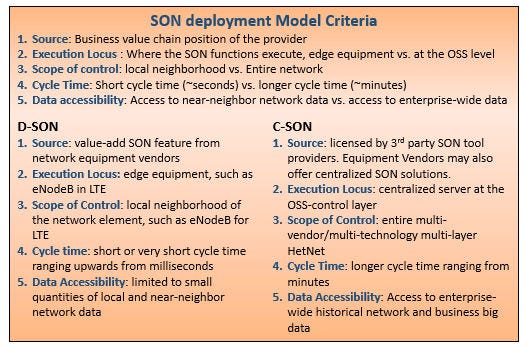Self-Organizing Networks (SON) – P.I. Works Perspective
To achieve the best results from SON, the Operator will need to deploy both D-SON and C-SON to address complex networks.
May 26, 2015

Telecoms.com periodically invites expert third-party contributors to submit analysis on a key topic affecting the telco industry. In this piece Michael Motta at PI Works, discusses the relative merits of the two deployment models for Self-Organizing Networks.
SON optimization has demonstrated improvements to the performance, capacity, and quality of mobile networks in real-world deployments. The financial benefits to the Mobile Network Operator of introducing SON are cost reductions by automating network operational tasks and capital expenditure reductions by increasing the efficiency of network infrastructure assets.
This paper explores the two deployment models for SON: centralized SON (C-SON) has a view to the entire network and distributed SON (D-SON) executes on Vendor equipment with limited scope of control at the edge of the network. To achieve the best results from SON, the Operator will need to deploy both D-SON and C-SON to address complex networks.

Based on language in 3GPP standards, some have publicized a category called Hybrid SON (H-SON). All of the properties of H-SON need to be available in minimally viable C-SON products. Since there are no practical differences between C-SON and H-SON, we cover only C-SON and D-SON here.
Radio Access Network Equipment Vendors offer D-SON to self-configure, optimize, and self-heal their proprietary equipment. D-SON runs on the Vendor’s edge equipment with limited scope and functionality. There are three significant limitations to deploying only D-SON.
Limited Data accessibility: D-SON algorithms have access to a limited set of data stored on edge elements, eNodeBs for LTE.
Scope of operation is restricted to a small set of neighboring nodes so as not to negatively impact the performance of the network by overloading the inter-node communication paths (X2 interface for LTE.) The Load and coordination overhead increase very quickly as the number of nodes increase. D-SON operates with limited knowledge and control.
Difficulty to handle multi-vendor configurations: D-SON Vendors optimize the performance of their own equipment using proprietary algorithms, data schema, and interfaces. The standards don’t currently define the implementation of D-SON functions. So it is not possible to make parameter updates reliably across D-SON Vendors because there are unknown consequences to these black-box updates. This can cause misalignment between neighboring nodes. The problem is particularly strong in small-cell deployment scenarios when multiple-vendor cells are serving same coverage area.
These difficulties with D-SON limit the ability of the Operator to realize the full benefits of SON. As stated by a recent Infonetics report, The Logical Rise of C-SON, “…the planet is becoming saturated with islands of D-SON coming from multiple RAN equipment Vendors.” Tying together these islands and extracting the value of the combined intelligence of C-SON and D-SON is a core objective of centralized SON.
C-SON is offered by 3rd-party SON solution providers. Equipment Vendors may also offer some form of centralized SON. C-SON executes at the level of the OSS using standardized IRP as well as proprietary interfaces. Benefits of C-SON are:
Flexibility of customization satisfies the unique needs and policies of the Operator
Access to the converged performance of the entire multi-vendor and multi-technology heterogeneous network (HetNet) including support for segregated shared network configurations
Ability to automate optimization and self-healing across network layers
Orchestration and coordination of multiple SON functions and across all Vendor-specific D-SON systems
Enrichment of SON functions by using business data, for example, Customer Experience Data (CEM) to improve subscriber experience
Self-learning capabilities based on patterns of historical network and business data
Capability to correlate data across different dimensions including performance measurements, fault management data, configuration changes, and element maintenance activities, etc. to improve root-cause analysis
C-SON and D-SON are complementary. D-SON uses a lower level, micro view of local regions of network performance to execute low-latency SON algorithms, such as Inter-cell Interference Coordination (ICIC), Automated Neighbor Relations (ANR), and some use cases of Energy Saving (ES), etc. On the other hand, C-SON operates from a big picture view of the entire network to execute SON algorithms across equipment Vendors, layers, and technologies over time. Also, by using data from Operator business systems, C-SON can optimize based on business requirements and not just on network needs. C-SON can orchestrate the parameterization and execution D-SON functions based on this broader knowledge.
The proliferation of stand-alone D-SON systems results in increased complexity. It is crucial for Operators to move from islands of standalone D-SON to a full integration with the entire network. This is achieved by deploying C-SON in concert with D-SON systems. The performance of the network is a function of the ability to treat multiple network dimensions as a whole. C-SON works with D-SON to ensure the best algorithms are applied with the best results.
 Michael Motta is Director of Product Engineering at PI Works. P.I.Works provides SON solutions to improve the performance of Mobile networks worldwide. Their purpose-built tools support performance monitoring and automated network optimization using Self-organized Networks (SON) techniques.
Michael Motta is Director of Product Engineering at PI Works. P.I.Works provides SON solutions to improve the performance of Mobile networks worldwide. Their purpose-built tools support performance monitoring and automated network optimization using Self-organized Networks (SON) techniques.
Read more about:
DiscussionAbout the Author
You May Also Like










.png?width=300&auto=webp&quality=80&disable=upscale)


_1.jpg?width=300&auto=webp&quality=80&disable=upscale)